Topics List
Jan. 20, 2015 Updated
Highly detailed data of far-infrared all-sky image
|
A team led by the University of Tokyo compiled a new far-infrared all-sky image using data acquired by the Infrared Astronomical Satellite AKARI. JAXA also cooperated with the team for image data compilation and its publication. |
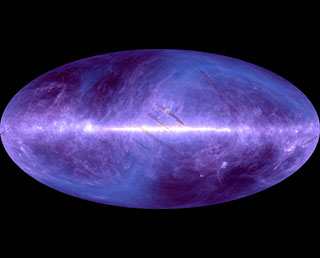
|
|---|
Mar. 20, 2014 Updated
AKARI made a step to a key to understand the material evolution in the universe
|
A team of astronomers based at the University of Tokyo has made a significant step in better understanding the material evolution of the universe. Led by Ms Tamami I. Mori, a research fellow for the Japan Society for the Promotion of Science, the study may help to give new insights into complex carbon chemistry in the galaxy. |

|
|---|
Jan. 11, 2013 Updated
Large Magellanic Clouds near-infrared spectroscopic catalog
|
JAXA released the"Large Magellanic Clouds (LMC) near-infrared spectroscopic catalogue" to the world that was compiled by observation data acquired by the infrared imaging satellite “AKARI.” The positional light source catalog released this time is one of the largest-scale LMC catalogs, and the first data as a “spectroscopic” catalog in the world. The catalog, which categorizes celestial bodies in the LMC, is significant data for greatly advancing research on newly born stars as well as already developed ones. |
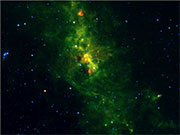
|
|---|
Feb. 8, 2012 Updated
AKARI detected carbon monoxide from supernova remnant
|
The infrared imaging satellite “AKARI” completed its operations on Nov. 24, 2011, but we are still analyzing its vast volume of observation data. We recently found carbon monoxide elements from a relatively young supernova remnant “Cassiopeia A.” A supernova remnant is believed to be filled with high-temperature gas thus no element can exist. Therefore, the discovery this time was unexpected. Furthermore, our findings showed that the volume of solid particles (dust) created by a supernova explosion in the early space age was fewer than expected, and that is another important discovery that may lead to a reconsideration of the existing scenario of substance evolution in space. |
 |
|---|
Nov. 24, 2011 Updated
AKARI operation completed
|
The operation of the Infrared Imaging Satellite "AKARI" (ASTRO-F) has been completed after the sending of signals was halted from Earth on Nov. 24 (at 5:23 p.m., Japan Standard Time) following the suspension of scientific observations due to a power generation anomaly on May 24, 2011. |
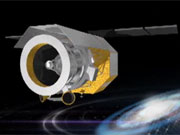 |
|---|
Oct. 21, 2011 Updated
AKARI detected the light from the first stars
|
Japanese infrared astronomy satellite AKARI measured the sky brightness at the wavelength of 1 - 4 micrometers and detected large spatial fluctuation that cannot be explained by the known sources. This fluctuation can be attributed to the clustering of the first stars of the universe, which were formed 300 million years after the Big Bang. The result will provide an important clue for the investigation of star formation history in the early universe for which little observational evidence has been found. The paper will be published in the November 1st issue of The Astrophysical Journal. |
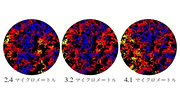 |
|---|
Oct. 13, 2011 Updated
Gold dust collection in the sky: World's largest asteroid database made by AKAR
|
The AKARI asteroid catalogue is constructed by laborious processes from the enormous quantity of data of the AKARI All-Sky Survey observations, like collecting gold dust. AKARI is the infrared astronomical satellite, which is a JAXA mission with ESA participation. The new AKARI asteroid catalogue contains 5120 asteroids and becomes the world's largest one. The catalogue will significantly contribute to progress of the asteroid research. |
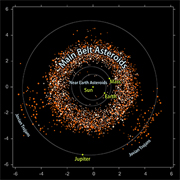 |
|---|
May 24, 2011 Updated
AKARI power anomaly
|
JAXA has been operating the Infrared Imaging Satellite “AKARI” (ASTRO-F,) which was launched on Feb. 22, 2006, past its target life of three years, and way beyond its minimum requirement operation period of one year. During those years, the AKARI compiled an astronomical catalog (an address book for a celestial body) and observed a Red Giant star with red infrared. At 5:30 a.m. on May 24, 2011 (Japan Standard Time), however, the satellite shifted its operation to energy-save mode, thus all onboard observation devices were turned off. |
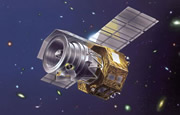 |
|---|
Mar. 25, 2011 Updated
AKARI observes dying stars' final phenomena
|
The Infrared Astronomical Satellite "AKARI" is observing the dusty veils of some Red Giant stars with unprecedented sensitivity and accuracy. |
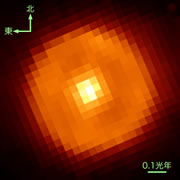 |
|---|
Jan. 17, 2011 Updated
AKARI and Suzaku confirm dust generation due to supernova burst
|
The Infrared Imaging Satellite "AKARI" and the X-ray Astronomy Satellite "Suzaku" have been observing remnants of a supernova commonly known as Tycho's supernova. |
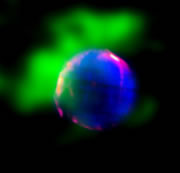 |
|---|
May 7, 2010 Updated
AKARI's scientific achievements featured in Astronomy and Astrophysics
|
AKARI's scientific achievements were specially featured in "Astronomy and Astrophysics," one of Europe's most prestigious magazines in this field, The magazine publishes 17 theses on various topics of AKARI's observations including a thesis specifically targeted on celestial bodies in the solar system and on the far-away galactic system. |
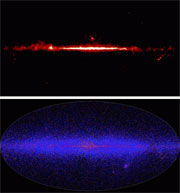 |
|---|
Mar. 30, 2010 Updated
AKARI All-Sky Survey Point Source Catalogues open to the world
|
AKARI All-Sky Survey Point Source Catalogues are a collection of information on about 1.3 million planets shining in infrared lights (like an address book), and today the catalogues become available to researchers world-wide. |
 |
|---|
Nov. 21, 2008 Updated
AKARI's recent highlight
|
|
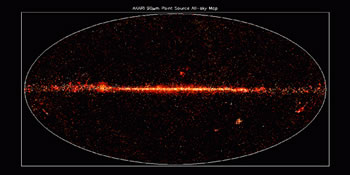 |
|---|
Mar. 24, 2008 Updated
AKARI captures birth of cosmic dust from supernova explosion!
|
A group consisting of the University of Tokyo, JAXA, Hokkaido University, Hiroshima University and other researchers made observations through the infrared astronomical satellite AKARI of the Supernova 2006jc discovered by Koichi Itagaki. The group tried to uncover the mysteries of the supernova through cooperative and continuous observations from the ground using the Subaru Telescope, the MAGNUM Telescope and the KANATA 1.5-m telescope. |
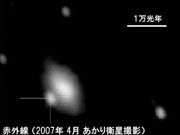 |
|---|
Sep. 5, 2007 Updated
Observational results from the infrared astronomical satellite AKARI
AKARI observes star-forming regions in near-by galaxies and the distant Universe
|
We report on the initial results from the data taken by the first dedicated Japanese infrared astronomical satellite AKARI, launched in February 2006. The group in the Graduate School of Science, Nagoya University has participated in the development of an onboard instrument, the Far-Infrared Surveyor (FIS). We are delighted to introduce the unique FIS instrument along with a pair of the initial scientific results from the instrument; the observation of the nearby galaxy M101 and the deep far-infrared sky-survey programme. These results will be presented in the Annual Meeting of the Astronomical Society of Japan to be held at Gifu University in September 26th--28th, and also reported in the Publications of Astronomical Society of Japan (AKARI first results special issue). Note that AKARI's FIS instrument successfully completed its mission observations on the evening of this August 26th in Japan. |
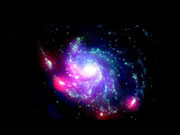 |
|---|
Aug. 28, 2007 Updated
AKARI finishes its cool observations
|
The infrared astronomical satellite AKARI ran out of its on-board supply of cryogen, liquid Helium at 08:33 (UT) on August 26th, 2007, after successful operation and observations that began on May 8th, 2006. The boil off of the liquid Helium signals the completion of observations at far-infrared and mid-infrared wavelengths with AKARI, including the All-Sky Survey. |
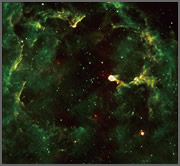 |
|---|
Jul. 11, 2007 Updated
Current Status of the AKARI Mission After one year of observations
|
The infrared astronomy satellite AKARI started the regular observations in May 2006. In the last one year, AKARI has carried out the All-Sky Survey observations to map the entire sky, as well as thousands of pointed observations of selected targets. Here we show the beautiful images constructed from the AKARI All-Sky Survey data; The entire sky in the mid-infrared light, the far-infrared image of the constellation Orion and the Milky Way, and the far-infrared image of the Cygnus-X region. |
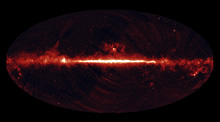 |
|---|
Nov. 2, 2006 Updated
"Akari" satellite about to complete its first scan of entire sky
Image of the Large Magellanic Cloud showing very active star formation
|
The infrared astronomical satellite "Akari" continues its mission to map the entire sky in infrared light. It will finish its first coverage of the entire sky in early November following almost 6 months of observations. The first scan is expected to cover about 70 percent of the entire sky excluding some areas disturbed by the moon. During the course of the first scan, the "Akari" successfully obtained detailed images of the Large Magellanic Cloud at near, mid and far infrared wavelengths. The Large Magellanic Cloud is an important observation target to study the birth of the Galaxy. |
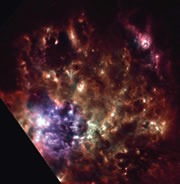 |
|---|
May 22, 2006 Updated
AKARI Initial Results
The infrared satellite AKARI (formerly ASTRO-F) of the Japan Aerospace Exploration Agency (JAXA), which was launched from the Uchinoura Space Center on the 21st of February (UT), captured light for the first time when the telescope aperture lid was opened on the 13th of April. After the aperture lid was jettisoned the instruments became fully operational and their performance was confirmed. Following this, the telescope focus adjustment and the optimization of the attitude control system, etc., were successfully carried out.
We have moved from the performance verification (PV) phase to Phase 1 (real observations) of the mission. Infrared images of world class resolution and sensitivity has been presented to the general public.
Feb. 22, 2006 Updated
ASTRO-F/M-V-8 successfully launched Nickname is "Akari"
|
JAXA launched the 21st Scientific Satellite (ASTRO-F) aboard the M-V Launch Vehicle No. 8 (M-V-8) at 6:28 a.m. on February 22, 2006 (Japan Standard Time, JST) from the Uchinoura Space Center (USC). |
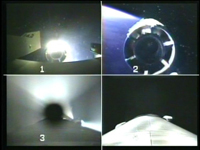 |
|---|
Nov. 4, 2005 Updated
Thermal vacuum test completed (Oct. 2005)
|
The ASTRO-F underwent a thermal vacuum test for 24 hours a day for 2 weeks between Oct. 1 and 16. The test is the final climax of a series of satellite integration tests. The thermal vacuum test is to check if the satellite equipment can maintain its function and work properly in the harsh space environment. The internal walls of the vacuum chamber, which is large enough to contain a satellite, were chilled by liquid nitrogen, and each satellite part was heated either internally or by heaters set near the satellite to create the rough space conditions. The test proved that each part of the satellite properly controlled its temperature as expected, thus the normal performance was verified. We would like to provide opportunities for astronomical researchers by sharing some of our observation time once the ASTRO-F is in space. We will accept applications until Nov. 18, 2005. The opportunities are provided during the "Phase 2" that starts just after its launch till about six months after the launch (until the helium coolant is used up). Some 30% of the observation time in the "Phase 2" will be allocated for publicly selected observation project(s), 10% for Europe, and 20% for Japan and Korea. We had an explanatory session for the applications in England, Spain, Korea and Japan, and that led to our high expectations for observations by ASTRO-F, as many people participated in the session in all four countries. |
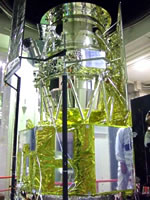 Photo 1 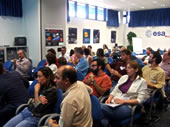 Photo 2 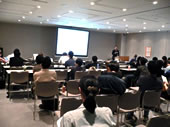 Photo 3 |
|---|
Jul. 25, 2005 Updated
Satellite tests smoothly in progress
|
We performed a vibration test on the satellite that was close to its flight configuration in June 2005, and verified that all devices and equipment were working properly after the test. We also carried out an operation called "baking" to prevent gases with impure objects that come out from the onboard equipment and electronic mother boards from negatively impacting the devices. To bake the satellite, it was put in an air-tight chamber (vacuum chamber) and warmed in vacuum to about 50 degrees Celsius to force impure gas to be released. Photo 2 shows the satellite in the chamber and some attachments. |
 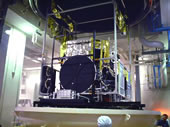 |
|---|
Jan. 27, 2005 Updated
Testing of observation equipment successful in Niihama and Sagamihara
|
In early December 2004, the observation equipment of ASTRO-F was tested at the Nihama Works of Sumitomo Heavy Industries, Ltd. (in Ehime Prefecture.) It was the first test since it had been assembled to form a flight structure, and both the coolant and observation instruments worked properly. It took over a week to measure the performance of various devices, and we were pleased to find that equivalent or better results were acquired compared with the unit-by-unit test data before the assembly. Data analysis is still going on, and when all is completed, the final estimated performance for flights will be obtained. The tested observation equipment was immediately transported back to the Sagamihara Campus (in Kanagawa) to be tested for vibrations in the cryogenic condition by liquid helium that is set at the same environment as that at the time of launch. The vibration test was completed on the evening of Dec. 28, 2004. On Jan. 6 and 7, the observation equipment was turned on to check its operation. Both the vibration test and operation check were successful, and the equipment of the ASTRO-F was found to be strong enough to withstand launch vibrations. |
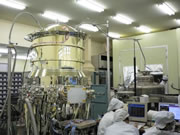 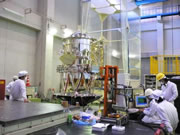 |
|---|
Sep. 2, 2004 Updated
ASTRO-F telescope passed the cryogenic vibration test
|
The ASTRO-F telescope passed the cryogenic vibration test. This is a very difficult test for high precision optical equipment such as telescopes, because the telescope is subjected to the equivalent vibration as that at liftoff under cryogenic conditions. The test was regarded as a critical point in the final verification test phase because an anomaly was found in the same test last year (damage to the support of the reflector) and that resulted in the re-manufacturing of the reflector. The test was held between June 28 and July 1, 2004 at the Sagamihara Campus (ISAS). When the temperature of the telescope returned to normal after the cryogenic and harsh vibrant conditions, it underwent post test inspections, namely a surface inspection, and an inspection for cracks at the pad connection part using ultrasonic waves. The telescope passed the test as no problem was found during the inspections. In order to further review its optical performance under cryogenic conditions, we are acquiring detailed data about a focal position and other aspects by cooling the telescope down to the absolute temperature of 9 degrees (minus 264 degrees Celsius). |
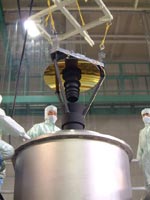 |
|---|
Apr. 12, 2004 Updated
Polishing of new flight model mirror completed
|
JAXA has been investigating the cause of an anomaly in the telescope mount that was found during the cryogenic vibration test in 2003, and consequently reviewed the design. |
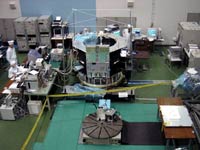 |
|---|
Dec. 4, 2003 Updated
Compatibility Test with Ground Equipment and System Proto-Flight Test
|
Recently a satellite integration test of the ASTRO-F satellite was completed. The satellite is now in storage. |
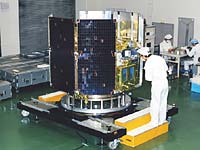 |
|---|